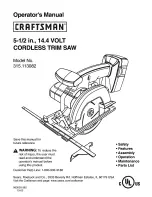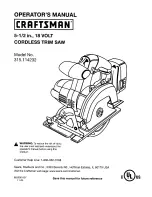
19
WARNING:
•
Never attempt to cut thick or round aluminum
extrusions.
Thick or round aluminum extrusions can
be difficult to secure and may work loose during the
cutting operation which may result in loss of control and
serious personal injury.
8. Wood facing
Use of wood facing helps to assure splinter-free cuts
in workpieces. Attach a wood facing to the guide fence
using the holes in the guide fence.
See the figure concerning the dimensions for a
suggested wood facing.
(Fig. 45)
CAUTION:
• Use straight wood of even thickness as the wood
facing.
WARNING:
•
Use screws to attach the wood facing to the guide
fence. The screws should be installed so that the
screw heads are below the surface of the wood
facing so that they will not interfere with the
positioning of the material being cut.
Misalignment
of the material being cut can case unexpected
movement during the cutting operation which may
result in a loss of control and serious personal injury.
NOTICE:
• When the wood facing is attached, do not turn the turn
base with the handle lowered. The blade and/or the
wood facing will be damaged.
9. Groove cutting (Fig. 46)
A dado type cut can be made by proceeding as
follows:
Adjust the lower limit position of the blade using the
adjusting screw and the stopper arm to limit the cutting
depth of the blade. Refer to “Stopper arm” section
described previously.
After adjusting the lower limit position of the blade, cut
parallel grooves across the width of the workpiece
using a slide (push) cut as shown in the figure. Then
remove the workpiece material between the grooves
with a chisel.
WARNING:
•
Do not attempt to perform this type of cut by using
a wider type blade or dado blade.
Attempting to
make a groove cut with a wider blade or dado blade
could lead to unexpected cutting results and kickback
which may result in serious personal injury
•
Be sure to return the stopper arm to the original
position when performing other than groove
cutting.
Attempting to make cuts with the stopper arm
in the incorrect position could lead to unexpected
cutting results and kickback which may result in serious
personal injury.
CAUTION:
• Be sure to return the stopper arm to the original
position when performing other than groove cutting.
Carrying tool (Fig. 47)
Make sure that the tool is unplugged. Secure the blade at
0° bevel angle and the turn base at the full right miter
angle position. Secure the slide poles so that the lower
slide pole is locked in the position of the carriage fully
pulled to operator and the upper poles are locked in the
position of the carriage fully pushed forward to the guide
fence (refer to the section titled “Slide lock adjustment”.)
Lower the handle fully and lock it in the lowered position
by pushing in the stopper pin.
Wind the power supply cord using the cord rests.
WARNING:
•
Stopper pin is only for carrying and storage
purposes and should never be used for any cutting
operations.
The use of the stopper pin for cutting
operations may cause unexpected movement of the
saw blade resulting in kickback and serious personal
injury.
Carry the tool by holding both sides of the tool base as
shown in the figure. If you remove the holders, dust bag,
etc., you can carry the tool more easily.
CAUTION:
• Always secure all moving portions before carrying the
tool. If portions of the tool move or slide while being
carried loss of control or balance may occur resulting in
personal injury.
MAINTENANCE
WARNING:
•
Always be sure that the tool is switched off and
unplugged before attempting to perform inspection
or maintenance.
Failure to unplug and switch off the
tool may result in accidental start up of the tool which
may result in serious personal injury.
•
Always be sure that the blade is sharp and clean
for the best and safest performance.
Attempting a
cut with a dull and/or dirty blade may cause kickback
and result in a serious personal injury.
NOTICE:
• Never use gasoline, benzine, thinner, alcohol or the
like. Discoloration, deformation or cracks may result.
Adjusting the cutting angle
This tool is carefully adjusted and aligned at the factory,
but rough handling may have affected the alignment. If
your tool is not aligned properly, perform the following:
1. Miter angle (Fig. 48)
Push the carriage toward the guide fence and tighten
the locking screw to secure the carriage.
Loosen the grip which secures the turn base. Turn the
turn base so that the pointer points to 0° on the miter
scale. Then turn the turn base slightly clockwise and
counterclockwise to seat the turn base in the 0° miter
notch. (Leave as it is if the pointer does not point to
0°.) Loosen the hex sockets bolts securing the guide
fence using the socket wrench.
(Fig. 49)
Lower the handle fully and lock it in the lowered
position by pushing in the stopper pin. Square the side
of the blade with the face of the guide fence using a
triangular rule, try-square, etc. Then securely tighten
the hex socket bolts on the guide fence in order
starting from the right side.
(Fig. 50)
Summary of Contents for LS1017
Page 2: ...2 1 2 3 4 5 6 7 8 1 2 2 3 3 4 5 6 7 4 8 9 10 11 13 12 14 ...
Page 3: ...3 9 10 11 12 13 14 15 16 15 16 17 18 19 20 21 21 22 18 23 21 18 24 23 25 26 21 27 28 ...
Page 4: ...4 17 18 19 20 21 22 23 24 26 27 28 29 30 31 32 33 1 34 35 36 37 3 ...
Page 6: ...6 33 34 35 36 37 38 51 52 53 5 14 54 55 52 56 25 57 ...
Page 8: ...8 47 48 49 50 51 52 53 54 14 69 20 14 70 5 18 17 21 22 71 72 70 6 12 5 18 23 ...
Page 9: ...9 55 56 57 73 72 74 75 ...
Page 119: ...119 ...
Page 120: ...ALA Makita Corporation Anjo Aichi Japan JM2318A026 www makita com ...
















































